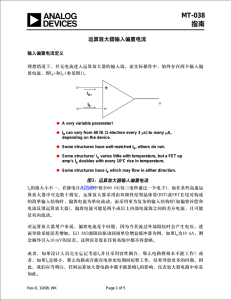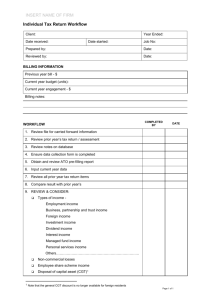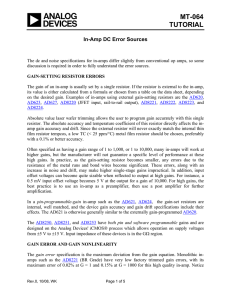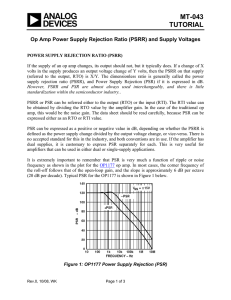MT-039 TUTORIAL Op Amp Total Output Offset Voltage Calculations
advertisement
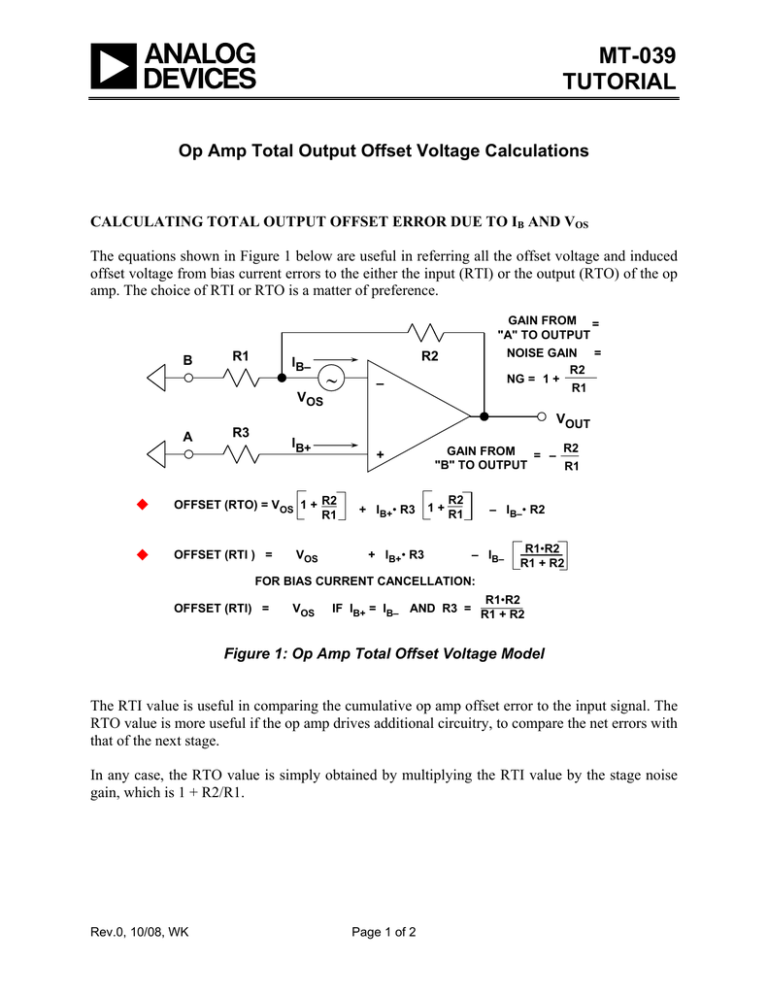
MT-039 TUTORIAL Op Amp Total Output Offset Voltage Calculations CALCULATING TOTAL OUTPUT OFFSET ERROR DUE TO IB AND VOS The equations shown in Figure 1 below are useful in referring all the offset voltage and induced offset voltage from bias current errors to the either the input (RTI) or the output (RTO) of the op amp. The choice of RTI or RTO is a matter of preference. GAIN FROM = "A" TO OUTPUT B R1 IB– NOISE GAIN = R2 NG = 1 + R1 R2 ∼ – VOS A VOUT R3 IB+ + OFFSET (RTO) = VOS 1 + R2 R1 OFFSET (RTI ) = VOS + IB+• R3 + IB+• R3 R2 GAIN FROM = – "B" TO OUTPUT R1 1+ R2 R1 – IB–• R2 – IB– R1•R2 R1 + R2 FOR BIAS CURRENT CANCELLATION: OFFSET (RTI) = VOS R1•R2 IF IB+ = IB– AND R3 = R1 + R2 Figure 1: Op Amp Total Offset Voltage Model The RTI value is useful in comparing the cumulative op amp offset error to the input signal. The RTO value is more useful if the op amp drives additional circuitry, to compare the net errors with that of the next stage. In any case, the RTO value is simply obtained by multiplying the RTI value by the stage noise gain, which is 1 + R2/R1. Rev.0, 10/08, WK Page 1 of 2 MT-039 Before departing the topic of offset errors, some simple rules towards minimization might bear repetition: • Keep input/feedback resistance values low, to minimize offset voltage due to bias current • • • • • effects. Use a bias compensation resistance with VFB op amps not using internal bias compensation. Bypass this resistance, for lowest noise pickup. If a VFB op amp does use internal bias current compensation, don't use the compensation resistance. When necessary, use external offset trim networks, for lowest induced drift. Select an appropriate precision op amp specified for low offset and drift, as opposed to trimming. For high performance, low drift circuitry, watch out for thermocouple effects and used balanced, low thermal error layouts. REFERENCES: 1. Hank Zumbahlen, Basic Linear Design, Analog Devices, 2006, ISBN: 0-915550-28-1. Also available as Linear Circuit Design Handbook, Elsevier-Newnes, 2008, ISBN-10: 0750687037, ISBN-13: 9780750687034. Chapter 1. 2. Walter G. Jung, Op Amp Applications, Analog Devices, 2002, ISBN 0-916550-26-5, Also available as Op Amp Applications Handbook, Elsevier/Newnes, 2005, ISBN 0-7506-7844-5. Chapter 1. Copyright 2009, Analog Devices, Inc. All rights reserved. Analog Devices assumes no responsibility for customer product design or the use or application of customers’ products or for any infringements of patents or rights of others which may result from Analog Devices assistance. All trademarks and logos are property of their respective holders. Information furnished by Analog Devices applications and development tools engineers is believed to be accurate and reliable, however no responsibility is assumed by Analog Devices regarding technical accuracy and topicality of the content provided in Analog Devices Tutorials. Page 2 of 2
